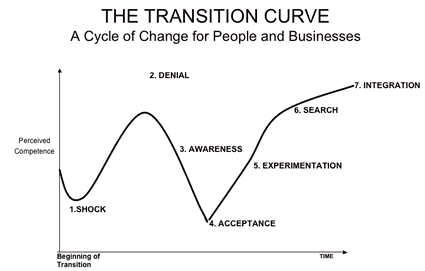change and change management
Change for emergentedge is like learning - it is a process rather than an event.
Our personal responses to change vary dramatically and we need to understand where in the process we feel most comfortable and where we feel least at ease. Learning how to behave and how to lead ourselves and others through each of the phases is key to changing the percentage likelihood of success.
The Transition Curve
Our Transition Curve is built on the work of many innovators in the area of change, grief, loss and chaos.

Change, or even improvement, is rarely embarked upon without there being a precipitated event. For the sake of this walkthrough, let's describe the initial event as being the arrival of sales data within a boardroom review that indicates that assumptions about sales volume are not being achieved and that forecasts show an increasing slump over the next two quarters.
The event creates a degree of shock - a destabilisation of what had been expected, often with no warning that it was coming!
The initial reaction of the board is to ask 'why?' They need information and are seeking to clarify the situation, yet their questioning style tends to prompt the sales director to try and 'explain away' the data.
'Don't worry', says the sales director, 'we are putting in place a new incentive programme and we've already seen indications that this new package will stimulate wholesale and retail activity within the next six to eight weeks'. This denial is potentially based on the 'truth' but the impact is to stifle concern within the board. It creates a level of reassurance without substance but it is welcome by everyone as the alternative is difficult to comprehend.
Rightly so the FD and CEO ask to be kept up to speed with progress and the marketing director and the sales director are asked to work on re-cutting the sales and marketing plans until the end of the year.
This 'activity' further reassures everyone that progress is being made until such time that a new set of figures are released that show that the early recovery made by the dealer incentive programme has failed to convert into retail sales and the problem is back on the agenda of the board meeting.
This heightened level of shared awareness now impacts everyone in the boardroom and the group take time to review the situation in depth – reviewing all the information available and looking for the real reasons behind the underperformance. No blame is handed out and no judgements are made – the group simply and calmly review all of the information and the related data to reach a level of consensus, understanding and acceptance of the real issues.
Once the reality of the situation is appreciated it becomes possible to make reasoned and appropriate suggestions as to how the situation can be handled and ideas of experimentation are raised. The process of problem solving is entered into and the outcome is likely to be a series of parallel activities that generate short, medium and long-term feedback about key indicators in performance that can be monitored in a more real-time 'dashboard' fashion.
As the effectiveness, or otherwise, of the action taken is monitored it becomes possible to search for other areas of the business model that can be improved or altered because of this enhanced understanding and eventually a process of integration is entered into which leads to the new and improved ways of working becoming part of the 'fabric' of the organisation.
Although rarely done as calmly as this little story might indicate, we work with many organisations where this would not be an usual story. We also work in organisations where the process is corrupted away from
1-2-3-4-5-6-7 to 1-2-3-5 .. 1-2-3-5 .. 1-2-3-5 .. 1-2-3-5. Genuine acceptance of the reality is not reached. The perceived need to fix the problem leads the team and individuals to dive between awareness and experimentation without actually saying 'Hang on, what does this really mean for us? Have we got the full picture or are we fooling ourselves?'
The outcome of the corrupted process is that the team get stuck in a loop between experimentation and shock – a process that creates a lot of activity but no real sense of progress or improvement.
The leadership challenge is to guide themselves as individuals and their teams through the process efficiently and effectively in order to ensure successful integration of change and achievement of the results that the organisational situation demands.
